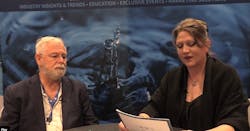NEW YORK, NY, Dec. 17, 2010 -- The U.S. Environmental Protection Agency (EPA) today presented GE with requirements for the next phase of the cleanup of the Hudson River. The second phase of the cleanup -- which is designed to address potentially cancer-causing chemicals released for decades from two GE plants into the Hudson -- would require GE to remove far more contaminated sediment from the river before sealing or "capping" any remaining PCBs. The decision follows months of consultation with GE, the State of New York and a wide range of stakeholder groups as the Agency analyzed technical information and decided how best to proceed with the second phase of the project. GE has until January 14, 2011 to review EPA's decision and notify the Agency whether they will proceed with this phase of the cleanup, scheduled to begin in May 2011
GE plants discharged approximately 1.3 million pounds of polychlorinated biphenyls (PCBs) during a 30 period ending in 1977, contaminating nearly 200 miles of the Hudson River. These potentially cancer-causing chemicals can build up in fish over time, posing a serious risk to those who eat them.
"We've said from the start that a clean Hudson is non-negotiable, and the path we have laid out today relies on the best science to ensure this dangerous pollution is addressed in an effective way," said EPA Region 2 Administrator Judith Enck. "EPA has advanced a PCB cleanup plan that will require the removal of huge quantities of PCBs, making the Hudson River cleaner for future generations."
The cleanup of this site, one of the largest Superfund sites in the country was divided into two phases. Under EPA's direction, GE began the first phase in May 2009, completing it in November 2009. EPA conducted a comprehensive review of the science and considered the views of a group of independent scientific experts following the completion of the first phase.
In the first phase of the cleanup, nearly 37% of the area was capped due to the continued presence of contamination, despite multiple dredging passes that removed the great majority of the PCBs. Capping in 15% percent of the area was unavoidable because of physical barriers in the river, leaving 22% percent capped in areas without these barriers. While fish and other aquatic life are not exposed to the contamination in the capped areas, the Agency has determined that it is necessary in Phase 2 to set a stringent limit on what percentage of the total project area can be capped if dredging does not meet the cleanup goals. This limit will be set at 11% of the total project area, not counting those areas where capping is unavoidable. This limit represents a significant improvement from Phase 1 and will require GE to employ considerably more rigorous dredging procedures.
Dredging during the second phase will go deeper into the sediment and, by relying on better information and lessons learned during the first phase, will remove more contaminated sediment in fewer passes. Phase two will require GE to remove an estimated 95 percent or more of PCBs from the areas designated for dredging.
If GE does not agree to conduct the Phase 2 dredging, EPA fully reserves all of its enforcement authorities, including its right to order GE to perform the dredging, or take legal action to require GE to perform Phase 2 or to reimburse EPA for its costs of the cleanup if the Agency performs the cleanup using taxpayer funds.
The documents issued by EPA today and other information about the Hudson River PCBs Superfund Site can be found at: http://www.epa.gov/hudson. Residents with questions are encouraged to contact EPA Community Involvement Coordinator David Kluesner at (212) 637-3653, [email protected].
###


